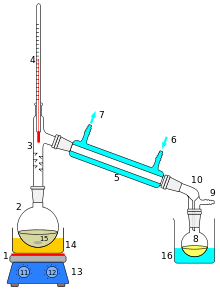Chemical Impurity
This article includes a list of general references, but it lacks sufficient corresponding inline citations. (January 2021) |
In
The levels of impurities in a material are generally defined in relative terms. Standards have been established by various organizations that attempt to define the permitted levels of various impurities in a manufactured product. Strictly speaking, a material's level of purity can only be stated as being more or less pure than some other material.
Impurities are either naturally occurring or added during synthesis of a chemical or commercial product. During production, impurities may be purposely or accidentally added to the substance. The removal of unwanted impurities may require the use of separation or purification techniques such as distillation or zone refining. In other cases, impurities might be added to acquire certain properties of a material such as the color in gemstones or conductivity in semiconductors. Impurities may also affect crystallization as they can act as nucleation sites that start crystal growth. Impurities can also play a role in nucleation of other phase transitions in the form of defects.
Unwanted Impurities
Impurities can become unwanted when they prevent the working nature of the material. Examples include ash and

However, some kinds of impurities can be removed by physical means. A mixture of water and salt can be separated by distillation, with water as the distillate and salt as the solid residue. This is done by heating the water so it boils and leaves behind the salt. The water is cooled and the gas turns back to a pure liquid.[3] Impurities are usually physically removed from liquids and gases. Removal of sand particles from metal ore is one example with solids.
No matter what method is used, it is usually impossible to separate an impurity completely from a material. The reason that it is impossible to remove impurities completely is of thermodynamic nature and is predicted by the second law of thermodynamics. Removing impurities completely means reducing their concentration to zero. This would require an infinite amount of work and energy as predicted by the second law of thermodynamics. What technicians can do is to increase the purity of a material to as near 100% as possible or economically feasible.[4]
Impurities in pharmaceuticals and therapeutics are of special concern and the last couple of decades have witnessed a fair number of scandals, from insecure ingredients and incorrect dosage forms to intentionally fortified medications and accidental contaminations.[4]
Wanted Impurities
Occasionally, we may want to include impurities in a material to change its properties. These impurities can be naturally occurring and left unaltered in a material or be intentionally added during synthesis. These types of impurities can show up in our day to day lives such as different colors in gemstones or by doping to tune the conductivity of semiconductors.[5][6]
An example of when impurities are wanted is shown in gems. These gems have slight impurities that act as chromophores and give the stone its color. An example is the gem family beryl witch has the base chemical formula of Be3Al2(SiO3)6. Pure beryl will appear colorless but this rarely occurs and the presence of trace elements change its color. The green of emeralds are from impurities such as chromium, vanadium, or iron. A manganese impurity will give a pink gem called morganite and iron creates the blue gem aquamarine.[5]

Doping is a process where impurities are purposefully added to semiconductors to increase electrical conductivity and improve a semiconductors function. The dopants, the elements added to the original crystal structure, contain a different number of electrons then the base formula. Semiconductors that are p-doped contains a small amount of elements that have less valence electrons then the other elements in the crystal. N-doping is the opposite and the dopant contains more valence electrons.[6]
Impurities and Nucleation
When an impure liquid is cooled to its
Impurities play an important role in the nucleation of other phase transitions. For example, the presence of foreign elements may have important effects on the mechanical and magnetic properties of metal alloys. Iron atoms in copper cause the renowned
See also
References
- ^ "Definition of IMPURITY". www.merriam-webster.com. 2024-03-24. Retrieved 2024-04-01.
- ^ "Definition of HOMOGENEOUS". www.merriam-webster.com. 2024-03-10. Retrieved 2024-03-27.
- ISBN 978-0-429-10729-0.
- ^ PMID 32041209.
- ^ a b Smith, George Frederick Herbert. "Gem-Stones and Their Distinctive Characters". gutenberg.org. Retrieved 2024-04-15.
- ^ ISBN 978-1-118-57380-8.
- PMID 32905065.
- Cheng, E. et al., Chemistry – A Modern View, Aristo-Wilson, Hong Kong, 2004
